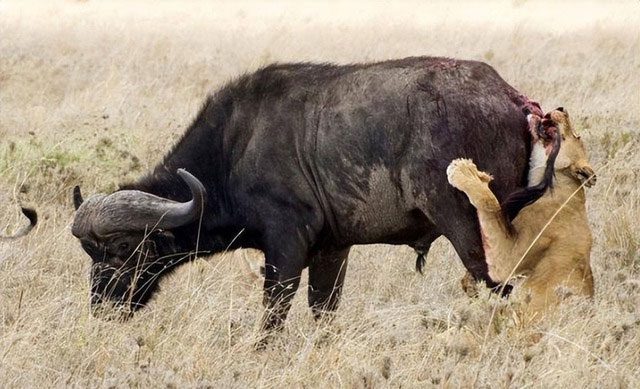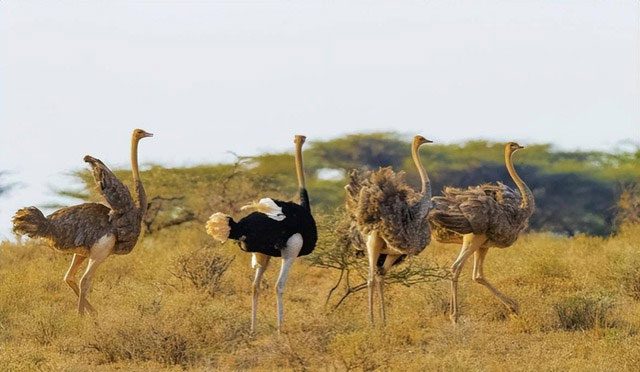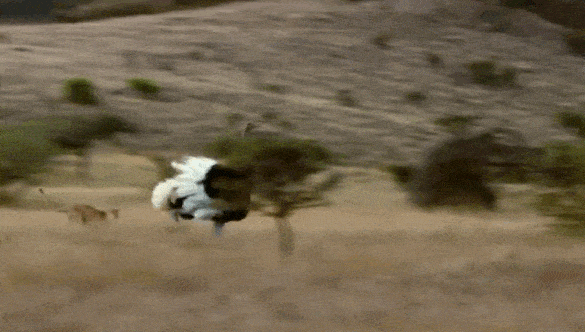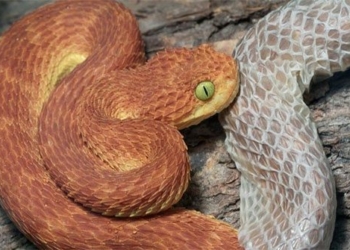Although ostriches have excellent self-defense capabilities, why do lions, the top predators of the African savannah, rarely prey on them?
In our impression, the African buffalo is always considered the primary prey of lions. Despite being herbivores, these animals are incredibly strong fighters. An adult African buffalo can measure around 2.1 to 3.4 meters in length, stand about 1.5 meters tall, and weigh between 500 to 800 kg.

African buffalo accounts for 65% of a lion’s diet, while giraffes and zebras make up 21%, warthogs and wildebeests account for 11%, other animals comprise 3%, and ostriches represent less than 1%. So why does the African ostrich, measuring approximately 180 to 300 cm in length, standing 240 to 280 cm tall, and weighing between 130 to 150 kg, with an average lifespan of 60 years and lacking the “weapons” of an African buffalo, have such a small representation?
Compared to other prey like zebras, wildebeests, and antelopes, ostriches have significantly less meat. The majority of an ostrich’s body consists of bones, neck, and feathers, making it energy-inefficient for lions to hunt them.
1. Ostriches are Highly Alert
Although ostriches have lost their ability to fly due to their large size during evolution, they still belong to the class of birds. The alertness of birds can be seen in sparrows, pigeons, hawks, and other common bird species around us.
Ostriches are therefore much more alert compared to African buffaloes, giraffes, zebras, and others. Even when drinking water, there are ostriches assigned to keep watch.
The terrain of the African savannah is flat, and with an average height of 2.5 meters, an ostrich has a wide field of vision, allowing them to easily spot lions and flee before coming into the lion’s sights.

Ostrich – the land animal with the largest eyes, with a diameter of up to 5 cm, helps them observe a vast area around them. Their eyes are positioned high on their heads, allowing them to see enemies from a distance, even when they are bent down foraging. This species also has very sensitive hearing, capable of detecting sounds from kilometers away. This helps them identify the footsteps of potential predators and timely alert the flock.
2. Ostriches Run Fast
The evolutionary process of species in nature is continuous. Although ostriches have lost their ability to fly and often weigh up to 150 kg, their long legs and slender neck make up two-thirds of their body ratio.
The stride of an adult ostrich can reach 3 to 5 meters, and they can run at speeds of up to 70 km/h. Imagine driving a car and accelerating to 70 km/h; that’s how fast an ostrich can run.
Meanwhile, lions can run up to 80 km/h. This suggests that lions appear faster than ostriches, but in reality, in this race, lions have no advantage. Although lions can reach speeds of up to 80 km/h, due to their large size and limited stamina (their hearts are quite small compared to their body), they can only maintain this speed for about 3 minutes. In contrast, ostriches can run at 70 km/h for over 5 minutes, with some even exceeding 10 minutes. Thus, it can be seen that chasing an ostrich is extremely challenging for lions.

Ostriches are the fastest running birds, reaching speeds of up to 70 km/h. This makes it difficult for lions to approach and take down ostriches.
3. Ostriches Can Strike Back at Lions
When hunting, lions generally prioritize older or younger buffaloes because their reactions are relatively slow, which is completely different from ostriches.
The reason they do not dare confront an adult buffalo is that top predators know how to seek advantages and avoid disadvantages. If a lion is gored by an adult buffalo, it could face a slow and painful death.
Moreover, ostriches also have the ability to strike back at lions with significant damage. Ostriches can kick very hard with both legs. Their kicking force is strong enough to break ribs or even kill a wolf. Additionally, they have sharp claws on both feet, up to 7 cm long. These claws can inflict severe injuries, even fatal ones, to lions if they strike the eyes or neck.

Chasing ostriches poses many risks for lions. Ostriches have sharp claws like daggers on each foot, capable of inflicting serious injuries or even death to attackers if struck at weakness points, or even lions may become exhausted during the pursuit.




















































